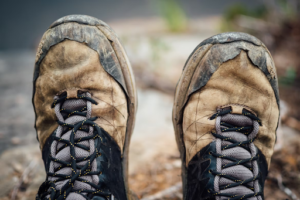Hiking season is coming up, and we are itching to get out on the trails! Here are a few tips & tricks that will help your spring hiking season get off to a great start.
Get Your Body Ready
A common mistake that hikers make every spring is to think that they can pick up exactly where they left off in the fall. Even if we’ve been active through the winter, it can take some time before our hiking legs are back and ready to work at full capacity.
It takes a lot less time and effort to reawaken our muscles than it took to build them up in the first place. Don’t be disheartened if the first few hikes in the spring feel a little rough!
Get out walking and hiking whenever you can. The best way to get fit for hiking is by going on walks and hikes of increasing volume, but don’t overdo it. The best training is long duration (at least an hour) and low intensity (you should be able to speak a whole sentence without gasping).
Consider a strength training program that includes lunges, squats, and single leg balance exercises. Check in with your doctor or physiotherapist if you’re not sure where to start or are coming back from an injury.
If it’s still snowy out, try getting out on snowshoes, either on a guided trip or with a local club.
Get Your Gear Ready
Before you get back out on the trail, we want to take care of our hiking gear and make sure it is up to the task. Carefully inspect, test, and repair all your equipment ahead of time so you can hit the spring trails ready to go. The Ten Essentials is a good starting list of equipment your group should have. Then check the most important gear to see if it’s ready to go.

Boots
Start with the tread. Do your boots still have good lugs or have they worn down to little nubs? Some boots can be resoled for a fraction of the cost of buying new, so if your treads are worn down but the upper part of the boot still has some life, this can be a good option.
Next, examine the upper part of the boot for scratches, tears, or worn areas. It’s usually worthwhile to treat your boots with waterproofing each spring so you can tackle mud puddles with confidence.
Hiking Poles
Check if all the mechanisms work correctly. Sand and dirt can get into the joints of extendable poles and make them difficult to operate, so clean these out if you can. Look at the tip of the pole, is it still a metal tip that will stick into dirt and ice? Or is it worn down to a smooth nub? Most hiking poles have replaceable tips, and fresh ones will give you extra grip on icy trail sections.
Hiking Cleats
Spring hikes are often icy, and hiking cleats can transform a slippery terror-walk into a joyful stroll. The best hiking cleats are the microspike style, which look like winter car tire chains for your feet. They have rubber uppers and ¼” spikes on the bottom that give great traction without being a tripping hazard. Can you go spring hiking in Canada without ice cleats? Probably, but it will be less fun.
If you’ve hiked a few seasons on your cleats, take a close look and see if all the links are in good shape. The metal-to-rubber connection is what usually fails first. If the spikes have become dull, you can sharpen them yourself with a file.
Bear Spray
Our bear friends start to wake up and wander out of their dens as early as mid-March, so it’s time to think about bear safety. Check your bear spray to be sure it’s not expired and the safety is intact.
Get Your Plan Ready
It’s good to start off the season on a familiar hike that’s not too long. Hikes we’ve been on a few times work well as fitness benchmarks, and can give a good sense of what hikes we are up for next. Even the most experienced hikers need a mental shift from winter to summer, and it’s common to forget a few things the first time back out. By picking a hike that can accommodate a few mistakes and unknown fitness level, it becomes a fun (re)learning experience and not an accidental epic.

Some hikes are going to be nicer in spring than others. Hikes that will be fun in spring will have the these characteristics:
- Lower elevation
- On sunny aspects of mountains (In Prince George and BC in general this will be on the South side of hills/mountains)
- Waterfall viewpoints, since spring runoff can make many waterfalls big and impressive
- Bridges over water features or boggy areas (or no creek crossings at all)
- Ridges that drain well and have dry tops
Hikes that are better done later in the summer will have:
- Higher elevation
- Shady aspects (North side of mountains in BC)
- Alpine areas prone to winter/spring avalanches (check out www.avalanche.ca)
- Creeks that need to be waded across. Water levels will be lower later in the summer.
All Trails and local Facebook hiking groups are great places to read up on trail conditions to see what hikes are ready to go, and which ones are still mud-pits. If you do find yourself on a muddy hike, remember the best thing you can do for the trail is to hike right through the mud and don’t erode the sides of the trail and cause braiding and vegetation damage.
Think about slow progression from easy to harder hikes as the season progresses. Try to aim for hikes that are 10-15% bigger week to week if you are feeling good on them. If last week’s hike wiped you out, try for a similar or slightly easier hike this week.
Now you are ready to hit the trail and make this the best hiking season yet!
Article written by Susan Twitchell – ACMG Apprentice Hiking guide

